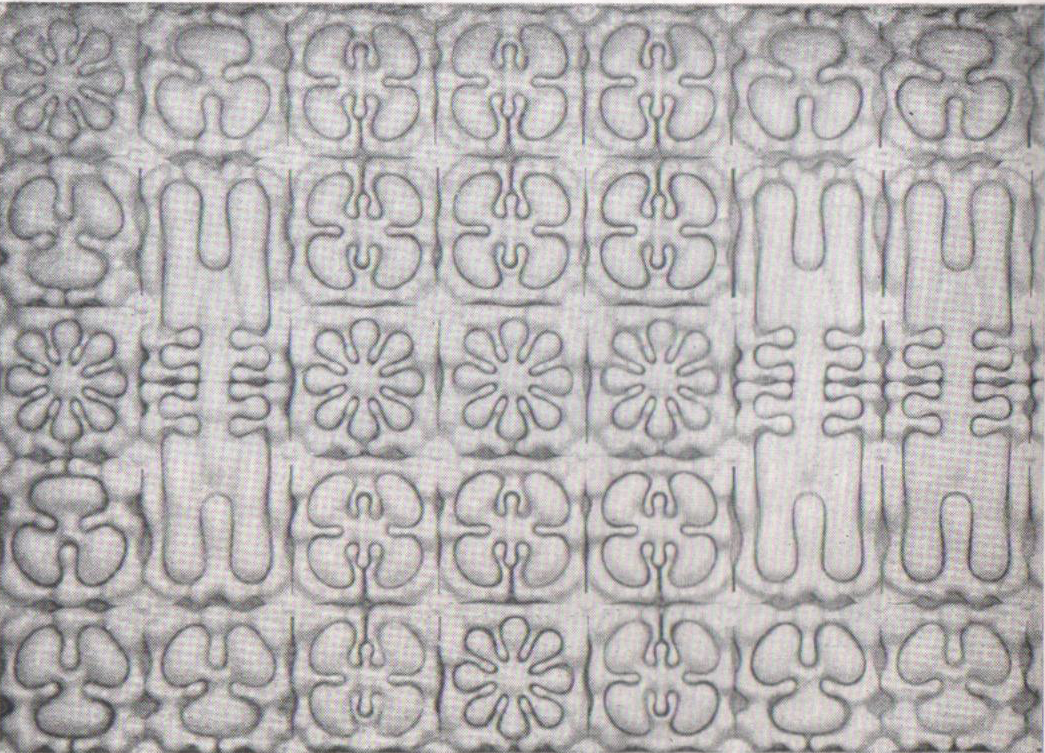Despite the Soviet ideology that regulated the evolution of art and limited individual expression, it is possible to identify positive shifts in the development of the applied arts in the early modernist period, namely the improvement and strengthening of the technical infrastructure and the establishment of the Dailė system of workshops that helped to ensure the production of artistic concepts. Communist Party directives calling for the domestic environment to be furnished with aesthetic objects and works of art to meet the needs of the era encouraged art theoreticians to devote more attention to the field, and artists to take up the design of such works. Fairly early on—in the second half of the 1950s—applied art was liberated from imposed narratives and a pomposity of form and artists began seeking simplicity in their imagery and persuasion through laconic compositions. The shift did not, however, signal a complete break with the past, since conservative trends still often appeared alongside more innovative ideas.
There was a large demand for applied artwork and many opportunities arose for artists to adapt their creations for both public consumption and domestic environments. Applied art designers contributed to the overall panorama of Lithuanian art with their own creations, though applied arts promoters were unable to fully overcome the unequal development of the different branches of applied art, as a more favorable position continued to be occupied by ceramics and textiles and those sectors benefitting from specialists trained and educated in Lithuania itself.
Modernization processes in the applied arts proceeded along lines similar to those being followed at the time by Lithuanian graphic art, painting, ceramics, and stained glass, namely moving from a reduction of form toward stylization, and from a recounting of a subject to a generalized notion. Ceramists, textile, leather, and metal artists developed similar themes, composition methods, and pattern styles. As the process of renewal in the arts progressed, applied art found itself in a more favorable position than the fine arts because of its direct association with architecture and its early embrace of simplified and stylized form, identified as a specific identifying characteristic of decorative art.
The directive to create “art for domestic life” ebbed and faded in the 1960s as mass production for consumers was taken up by the Dailė workshops and light industry factories, but the general interest in domestic design raised by the campaign played a positive role in improving the domestic culture overall and in abandoning the more conservative domestic environment that had prevailed thus far. In truth, this process developed far too quickly, and the public soon experienced the negative consequences of such a fundamental reimagining of the domestic environment, namely monotony in interior furnishing and an increasing similarity in the appearance of accessories (furniture, textiles, ceramics).
The Institute for the Applied and Decorative Arts in Kaunas and, from 1951 onward, the Lithuanian Art Institute trained many young specialists who later guided the development of the applied arts through the early modernist and subsequent periods. Many bright artistic individuals began their creative journeys at this time and, to the extent possible under Soviet artistic conditions, were able to realize their creative concepts, receive funding for them, and exhibit their work. The artists comprising this new creative force raised the artistic level of both their own unique works as well as that of the production line coming out of the Dailė workshop system.
Still, these artistic pursuits took place within the closed space of the Soviet Union and thus were limited by strict ideological rules. Artists were unable to break away from the trajectory of Soviet art, saturated as it was with declarative humanist ideals, to embrace even the margins of "unpromising bourgeois" art. Artists' aspirations were also held in check by self-censorship and the prevailing political environment: Soviet ideological favor and significant commissions first came to those artists who served the regime and who had succeeded in resisting "bourgeois propaganda."
Thus, the modernist breakthrough in the applied arts was a multifaceted phenomenon that laid the foundation for the future development of this field of art. The Lithuanian applied arts joined in the general Soviet artistic renaissance, looking toward the applied arts of Eastern and Central Europe as a guiding example, though Lithuanian artists never achieved such radical change as that enjoyed by Polish and Yugoslav textile artists or Czech ceramists and glass artists.




Comments
Write a comment